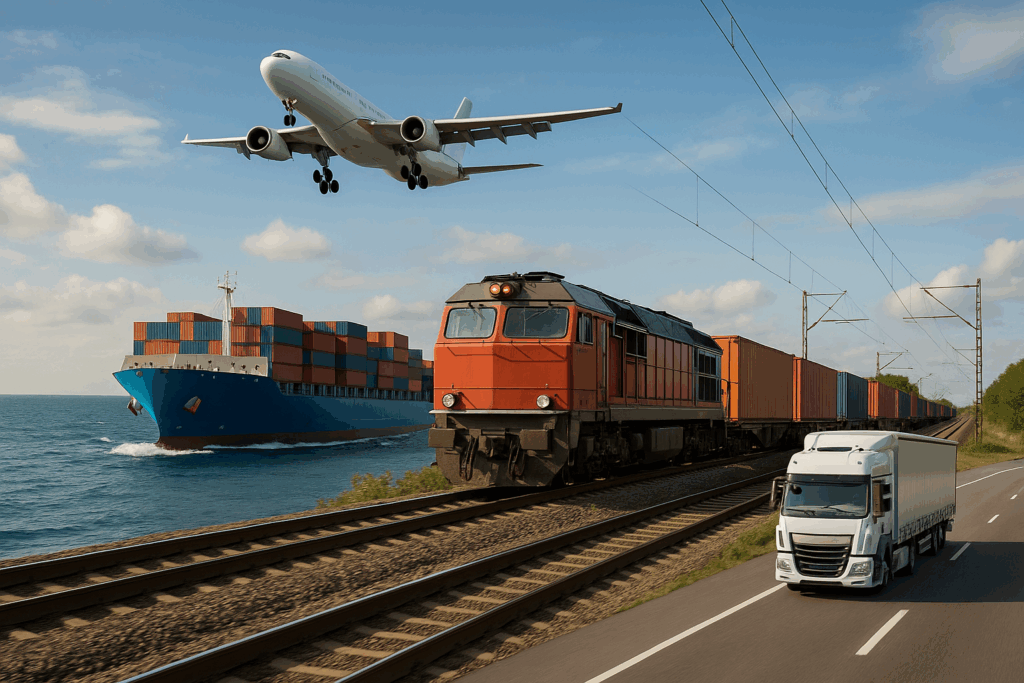Shipping freight to Indonesia is a vital part of international trade for companies sourcing goods from China, the U.S., and Europe. As one of the largest economies in Southeast Asia, Indonesia imports millions of containers every year. However, businesses often struggle with questions about costs, customs clearance, delivery times, and choosing between sea, air, or rail freight forwarding. This guide provides a complete breakdown of options, costs, and strategies to make your freight shipping smooth and profitable.

1. Sea Freight Costs to Indonesia: The Most Affordable Option
Sea freight to Indonesia is the most widely used method, especially for bulk shipments and heavy cargo. Businesses prefer this option because sea freight costs to Indonesia are significantly lower compared to air transport.
- China to Indonesia (Jakarta): 7–12 days
- U.S. West Coast to Jakarta: 25–35 days
- Europe to Indonesia: 30–40 days
Sea freight offers the lowest cost per cubic meter. For example, a 40ft container shipment can range from $1,500 to $4,000 depending on the route and season. However, businesses must plan ahead because transit times are long, and delays can occur during peak shipping periods.
2. Air Freight Shipping to Indonesia: Fast but Expensive
When speed matters, air freight shipping to Indonesia is the preferred solution. Perishable goods, electronics, and urgent spare parts often require quick delivery.
- China to Jakarta: 1–3 days
- U.S. to Indonesia: 5–7 days
- Europe to Indonesia: 6–9 days
Air freight ensures faster customs clearance and reliable schedules. The cost is calculated by weight or dimensional volume, averaging $4–$9 per kilogram. While more expensive than sea freight, it minimizes downtime for businesses that rely on just-in-time supply chains.
3. Multimodal Freight to Indonesia: Combining Efficiency
Indonesia does not have direct international rail freight access, but multimodal freight to Indonesia (rail + sea or rail + air) provides an efficient option for inland shippers. Cargo from inland Chinese provinces can be transported by rail to Shanghai or Shenzhen, then loaded on vessels bound for Jakarta. This approach balances speed and cost, especially for time-sensitive shipments that cannot rely solely on sea transport.

4. Freight Cost Comparison: Sea vs. Air vs. Multimodal
| Mode of Shipping | Transit Time | Average Cost | Best For |
|---|---|---|---|
| Sea Freight | 7–40 days | $1,500–$4,000 (per 40ft container) | Bulk, non-urgent goods |
| Air Freight | 1–9 days | $4–$9 per kg | Urgent, high-value cargo |
| Multimodal | 10–25 days | Combined rates | Time-sensitive inland shipments |
This table shows why many businesses use freight forwarders to Indonesia to help choose the best balance between cost and transit time.
5. Customs Clearance for Freight to Indonesia
Customs clearance in Indonesia is often a challenge for foreign businesses. Documents required include:
- Bill of Lading or Air Waybill
- Commercial Invoice
- Packing List
- Import Declaration (PIB)
- Import licenses (for restricted goods such as pharmaceuticals or electronics)
Errors in documentation can cause significant delays. Working with an experienced Indonesia freight forwarder ensures compliance with import laws and avoids costly penalties.
6. Common Challenges in Freight to Indonesia
- Port congestion at Jakarta’s Tanjung Priok port
- High customs duties on luxury and electronics imports
- Limited inland transport infrastructure outside Java island
- Seasonal freight surcharges during peak periods (before Ramadan, Christmas, and Chinese New Year)
Understanding these issues in advance allows companies to reduce risks and plan alternative routes when necessary.
- Consult TJ China Freight Forwarding for the lowest quote. They will provide you with reliable, cost-effective service.
7. Choosing the Best Freight Forwarder to Indonesia
Selecting the right freight forwarder can make or break your shipping experience. A reliable freight forwarder to Indonesia should offer:
- Strong presence at Indonesian ports
- Transparent pricing without hidden charges
- Door-to-door delivery and warehousing
- Customs clearance support
- Insurance and risk management services
8. Tips to Reduce Freight Costs to Indonesia
- Book shipments early to avoid peak season surcharges
- Use LCL (Less than Container Load) consolidation for small cargo
- Negotiate long-term contracts with carriers for better rates
- Optimize packaging to lower dimensional weight charges in air freight
- Explore multimodal transport options for inland shipments
These strategies can reduce your freight budget by 10–20% annually.

9. Transit Time Considerations for Indonesia Imports
Transit times depend on origin country, shipping method, and port congestion. Businesses often underestimate the impact of customs inspections, which can add 2–5 days to delivery schedules. By working with a forwarder that provides real-time freight tracking to Indonesia, you can monitor shipments and prepare for any delays.
10.Conclusion
Freight to Indonesia is an essential logistics route for global businesses. By choosing the right transport mode, preparing documents properly, and working with a trusted freight forwarder, you can minimize costs and shipping risks. Whether you prefer sea freight for cost savings, air freight for speed, or multimodal solutions for flexibility, the key lies in planning and expert support.
Request a Quote
Need a tailored solution for your shipping from China?
Let TJ China Freight Forwarder assist you with reliable, cost-effective service.
FAQ:
Q1.How much does it cost to ship freight to Indonesia?
Sea freight is $1,500–$4,000 per 40ft container, while air freight costs $4–$9 per kg.
Q2.How long does freight to Indonesia take?
Sea freight takes 7–40 days, air freight 1–9 days, and multimodal 10–25 days.
Q3.What documents are required for freight shipping to Indonesia?
Bill of Lading, Commercial Invoice, Packing List, Import Declaration, and sometimes import licenses.
Q4.What is the cheapest way to ship to Indonesia?
Sea freight is cheapest, especially when using LCL consolidation.
Q5.Can freight to Indonesia be tracked?
Yes. Most forwarders provide real-time tracking, especially for air freight shipments.
